
RESEARCH SCIENTIST
Livingston Ripley Waterfowl Conservancy
NUTRIENT ALLOCATION IN WATERFOWL
Samantha E. Richman (Livingston Ripley Waterfowl Conservancy), Keith A. Hobson (Environment Canada), and Shiway W. Wang (Sedna Ecological, Inc.)
The application of stable isotopes to describe animal diets and trace origins has revolutionized the way we study the ecology of individuals and communities. This is particularly true for birds, which have a variety of tissues that are easy to collect without destructive techniques. However, despite tremendous advances in this field, key parameters in isotopic models still require controlled laboratory investigation or ground-truthing for many species on isotopically distinct diets. By incorporating valid species-specific baseline values of isotopic discrimination factors, we can determine how nutrients are allocated from resources to tissues (blood, feather, claw, eggs). For example, a recent major development in the way we understand endogenous (e.g., nutrients from the body, termed ‘capital’) and exogenous (e.g., nutrients from the diet, termed ‘income’) contributions to eggs by laying female birds involves diets that differ in source nutrients. This approach has been largely successful in quantifying nutrient allocations, but relies on an untested assumption that the isotopic link between endogenous body tissues to eggs laid under a strictly capital strategy resembles that of a carnivorous bird under a purely income strategy The true capital discrimination factor remains elusive because it is generally difficult to get birds to lay in captivity without food. To study nutrient allocation to body tissues and eggs, we are using captive waterfowl (large carnivorous common eiders, omnivorous lesser scaup, and herbivorous black ducks) to determine isotopic discrimination factors for birds on single-source, homogenous diet that differ in source nutrients (fish meal of marine origin or corn-based terrestrial source). These results will provide the baseline data and foundation for future work to improve models incorporating stable isotopes to understand the ecology of waterfowl.
Postdoctoral Research Fellow
Program in Wildlife & Conservation Biology
Natural Resources Science, University of Rhode Island
GROWING FAST AND DYING YOUNG: INFLUENCE OF FORAGE QUALITY ON GROWTH AND SURVIVAL OF AVIAN HERBIVORES
Samantha E. Richman and Scott R. McWilliams (University of Rhode Island), in collaboration with James O. Leafloor (Environment Canada) and William H. Karasov (University of Wisconson-Madison)
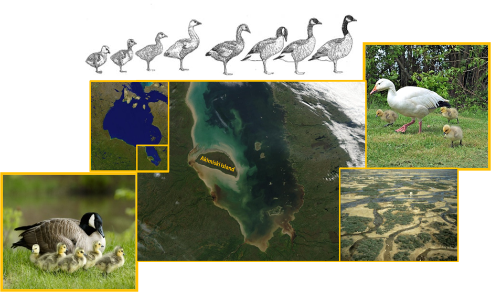
Avian herbivores such as geese in Arctic ecosystems are highly sensitive to reduced quantity and quality of available forage like that caused by overgrazing. To determine the effects of diet quality on growth and survival of sympatric goose populations, we raised 100 Canada and 100 Snow goose goslings on grass-based diets that included a factorial combination of three levels of protein (10, 14 and 20%) and two levels of neutral detergent fiber (30 and 45%), but similar energy content (~18 kJ/g). Survival of Snow but not Canada goslings was significantly affected by both dietary protein and fiber content. Goslings fed the low protein diets had ~40-65% lighter body mass and reduced structural growth compared to goslings raised on the higher protein diets. The effects of dietary fiber were more extreme for Snow compared to Canada gosling in part because Canadas increased food intake (corrected for body size) by ~100% while Snows increased food intake by only 15% when fed the high-fiber diets. Apparent Metabolizable Energy was similar between species, but lower for diets with high fiber content. Canada goslings had larger gizzard mass and small intestine length than Snow goslings in response to increased fiber content. These results indicate that Snow gosling had higher protein requirements than Canadas, and that there were interspecific differences in compensatory growth that were explained by their digestive physiology. Although phenotypic flexibility in gosling growth and digestive system allows geese to respond successfully to habitat change, there appears to be a lower limit to the quality of forage eaten (<10% protein and high fiber) that is to a degree species-specific.
Richman, SE, Leafloor, JO, Karasov, WH, and SR McWilliams (2014 Early view) Ecological implications of reduced forage quality on growth and survival of sympatric geese. Journal of Animal Ecology doi: 10.1111/1365-2656.12270 PDF
Richman, SE, Leafloor, JO, Karasov, WH and SR McWilliams (2012) Influence of forage quality of growth and survival of Canada and Snow goose goslings. North American Duck Symposium, Memphis, TN, Abstract PDF
Richman, SE, SR McWilliams, JO Leafloor and WH Karasov (2012) Growing Fast and Dying Young: Effects of foraging quality on growth and survival of Arctic herbivores. North American Ornithological Congress, Vancouver, British Columbia, Poster PDF

SEA DUCK PREDATION ON MUSSEL AQUACULTURE:
A GROWING CONFLICT
Samantha E. Richman (Université du Québec à Rimouski UQAR, Fisheries and Oceans Canada), Elisabeth Varennes (UQAR), Magella Guillemette (UQAR), Sveinn Are Hanssen (Norwegian Institute for Nature Research), and John Bonardelli (Shellfish Solutions)
The cultivation of blue mussels (Mytilus edulis) is a growing industry worldwide; however predation by migrating sea ducks has become an enormous challenge to mussel growers causing extensive financial losses. Mussels are a principle prey item for sea ducks, which take advantage of mussel farms that provide a highly abundant and easily accessible food source. Because cultivated mussels tend to have higher growth rates, thinner shells, and higher flesh content than intertidal mussels, farmed mussels are especially appetizing to migrating sea ducks, and a small flock can decimate a farm in a short period of time. To protect their farms, growers have adopted several techniques to deter ducks (including loud recordings, cannons, shooting, chasing, etc.) but all have had limited success and often lead to habituation. In Atlantic Canada, protective socking material has been tested, however results have indicated that the socking material may impact mussel growth rates and has limitations during production and harvest. Raft culture structures have used predator control nets which are highly effective. However, in areas prone to winter sea ice or long-line culture, use of predator control nets have limited application and may interfere with international wildlife laws. As a result, there is a pressing need for a practical, cost-effective, and conservation-friendly means to protect mussel farms without impacting species of conservation concern.
Richman, SE (2013) Sea duck predation on mussel aquaculture: a growing conflict - PDF

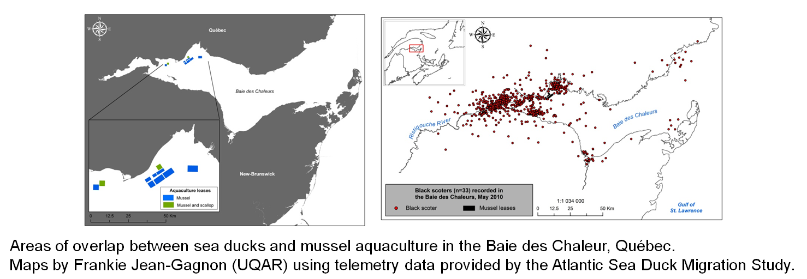

RESTING METBOLISM IN AIR AND ON WATER FOR AUKLETS AND OTHER DIVING BIRDS
Samantha E. Richman (University of Wyoming) and James R. Lovvorn (Southern Illinois University)
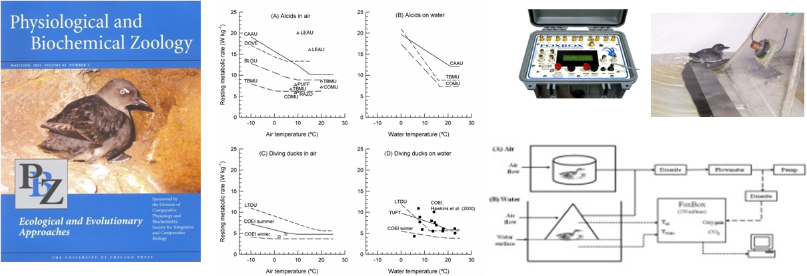
For small aquatic endotherms, heat loss while floating on water can be a dominant energy cost, and requires accurate estimation in energetics models for different species. We measured resting metabolic rate (RMR) in air and on water for a small diving bird, the Cassin’s auklet (Ptychoramphus aleuticus), and compared these results to published data for other diving birds of diverse taxa and sizes. RMR was higher on water than in air for alcids, cormorants, and small penguins but not for diving ducks, which appear exceptionally resistant to heat loss in water. Changes in RMR (W) with body mass either in air or on water were mostly linear over the 5- to 20-fold body mass ranges of alcids, diving ducks, and penguins, while cormorants showed no relationship of RMR with mass. The often large energetic effects of time spent floating on water can differ substantially among major taxa of diving birds, so that relevant estimates are critical to understanding their patterns of daily energy use.
Richman, S. E. and J. R. Lovvorn. 2011. Effects of air and water temperature on resting metabolism of auklets and other diving birds. Physiological and Biochemical Zoology 84:316-332. PDF
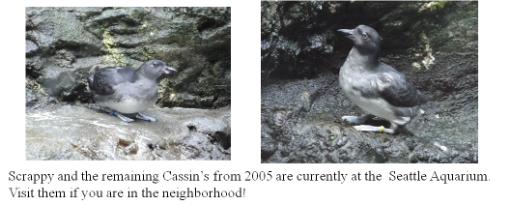

PREDATOR SIZE, PREY SIZE AND THRESHOLD FOOD DENSITIES: DOES A COMMON PREY BASE SUPPORT FEWER LARGE ANIMALS?
Samantha E. Richman (University of Wyoming) and James R. Lovvorn (UWyo, now at Southern Illinois University), in collaboration with John Y. Takekawa and Susan Wainwright de la Cruz (USGS San Francisco Bay)
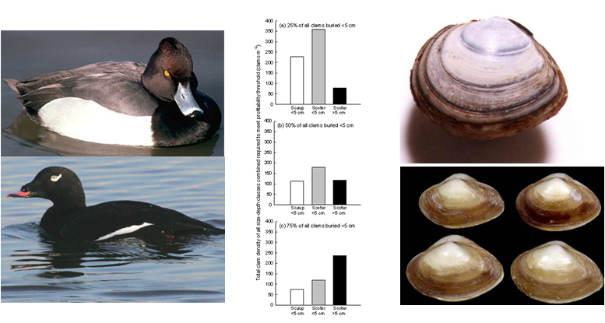
Allometry predicts that a given habitat area or common prey biomass supports fewer numbers of larger than smaller predators; however, birds from related taxa or the same feeding guild often deviate from this pattern. In particular, foraging costs of birds may differ among locomotor modes, while intake rates vary with accessibility, handling times, and energy content of different-sized prey. Such mechanisms might affect threshold prey densities needed for energy balance, and thus relative numbers of different-sized predators in habitats with varying prey patches. Our results show that threshold densities of total prey numbers for different-sized ducks depend on prey size structure and depth in the sediments. Thus, heterogeneity in disturbance regimes and prey population dynamics can create a mosaic of patches favoring large or small predators. Whether a given area or total prey biomass will support greater numbers of larger or smaller predators will vary with these effects.
Lovvorn, J.R., de la Cruz, S.E.W., Takekawa, J.Y., Shaskey, L.E., Poulton, V.K., and S.E. Richman (2013) Niche partitioning, threshold food densities, and species abundance in diminishing habitats for diving ducks. Marine Ecology Progress Series, 476:251-268 PDF
Richman, SE and JR Lovvorn (2009) Predator size, prey size, and threshold food densities of diving ducks: does a common prey base support fewer large animals? Journal of Animal Ecology 78:1033:1042 PDF
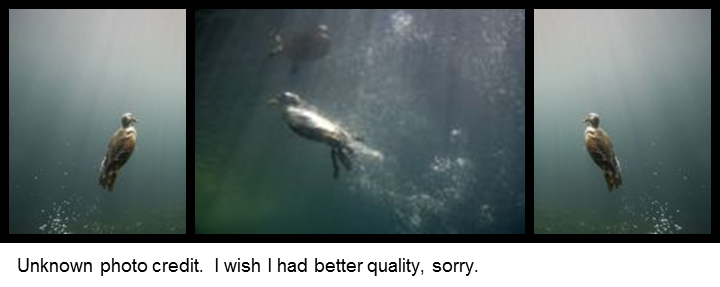
COST OF DIVING USING WING AND FOOT PROPULSION BY A SEA DUCK, THE WHITE-WINGED SCOTER
Samantha Richman (University of Wyoming) and James Lovvorn (UWyo, now at Southern Illinois University)
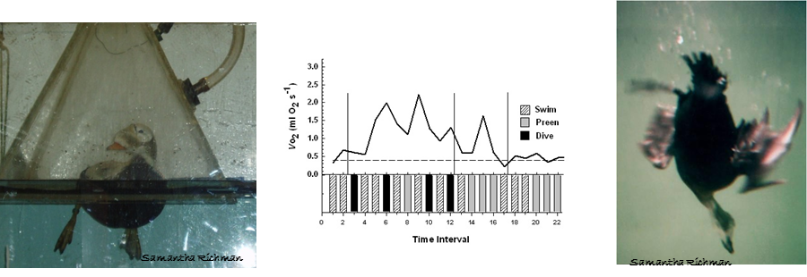
Photos of Spectacled eider under the metabolic dome and diving using wings as well as feet; similar to the white-winged scoter.
Most birds swim underwater by either feet alone or wings alone, but some sea ducks often use both. For white-winged scoters (Melanitta fusca), we measured costs (feet only vs. wings + feet simultaneously. Dive costs repaid during the recovery period after a dive bout were an important fraction (27–44%) of total dive costs, and removing costs of extraneous surface behaviors increased resolution of differences between dive types. Scoters using wings + feet had 13% shorter descent duration, 18% faster descent speed, 31% fewer strokes/m, and 59% longer bottom duration than with feet only. The cost of time underwater for dives using wings + feet was 32 to 37% lower than with feet only (P = 0.09 to 0.15). When indirect methods were used to partition descent costs from costs of ascent and bottom phases, using wings + feet lowered descent cost by an estimated 34%. Thus, using wings + feet increases descent speed and lowers descent cost, leaving more time and energy for bottom foraging. For birds in cold water, the large savings may result from both biomechanical and thermoregulatory factors.
Richman, SE and JR Lovvorn (2008) Cost of diving by wing and foot propulsion in a sea duck, the white-winged scoter. Journal of Comparative Physiology B 178:321-332 PDF

Check out a video from Joel Heath's study on common eiders diving under the Arctic sea ice. Sea ducks, like scoters and eiders, diving using their wings and feet in a coordinated stroke cycle that allows them to get to the bottom faster, stay down there longer, and use less energy to get there - enjoy!
ON THIN ICE: FORAGING ENERGETICS OF THE SPECTACLED EIDER WINTERING IN THE PACK ICE OF THE BERING SEA
Samantha E. Richman (University of Wyoming) and James R. Lovvorn (UWyo, now at Southern Illinois University) in collaboration with Jackie Grebmeier and Lee Cooper (University of Maryland)

The spectacled eider (Somateria fischeri), a Threatened species, winters in pack ice of the Bering Sea. In dives 40-70 m for benthic invertebrates, the high energy costs of foraging are offset by high benthic biomass. However, there is evidence that the dominant clam prey has changed from Macoma calcarea to Nuculana radiata, perhaps adversely affecting the foraging energetics of the eiders. We studied effects of differences in nutrient and energy content, crushing resistance of shells, digestibility, gut retention time, areal density, shell length, and depth in the sediments on the relative foraging value of M. calcarea vs Nuculana radiata. Considering energy content, digestibility, and intake rates at these burial depths for 1,200 clams m-2, energy assimilated was 14-19% higher for Nuculana radiata than M. calcarea of the same length classes. However, larger M. calcarea yielded 58% higher intake of assimilable energy than smaller Nuculana radiata; this pattern emphasizes that relative foraging value depends strongly on size (age) structures of different prey populations, which vary with recruitment, growth, and mortality in different seasons and years. Our results show that impacts of long-term benthic change on eiders depend not only on shifts in total clam abundance, but also on species differences in digestibility, size structure, and size-dependent nutrient content and burial depth.
Lovvorn, JR, JM Grebmeier, LW Cooper, JK Bump, and SE Richman (2009) Modeling marine protected areas for threatened eiders in a climatically changing Bering Sea. Ecological Applications 19:1596-1613. PDF
Richman, SE and JR Lovvorn (2003) Effects of clam species dominance on nutrient and energy acquisition by spectacled eiders in the Bering Sea. Marine Ecology Progress Series 261:283-297 PDF
Lovvorn, JR, SE Richman, JM Grebmeier, and LW Cooper (2003) Diet and body condition of spectacled eiders wintering in pack ice of the Bering Sea. Polar Biology 26:259-267. PDF
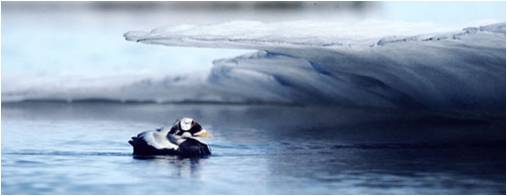
Unknown photo credit.

RELATIVE FORGING VALUE OF NATIVE AND EXOTIC CLAMS TO DIVING DUCKS IN SAN FRANCISCO BAY
Samantha Richman (University of Wyoming) and James Lovvorn (UWyo, now at Southern Illinois University) in collaboration with John Y. Takekawa and Susan Wainwright de la Cruz (USGS San Francisco Bay)
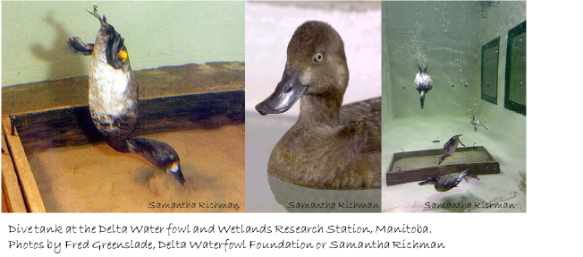
Richman, S. E. and J. R. Lovvorn. 2004. Relative foraging value to lesser scaup ducks of native and exotic clams from San Francisco Bay. Ecological Applications 14:1217-1231. PDF